Foveal translocation with 360° retinotomy best treatment option in subfoveal CNV
The procedure compares favorably with other techniques for predictability and visual acuity results.
TAORMINA, Italy - Foveal translocation with 360° retinotomy might be the most promising procedure for treatment of subfoveal choroidal neovascularization (CNV), according to a study presented at the Jules Gonin Club meeting here in Taormina by Masahito Ohji, MD, of Osaka University Medical School.
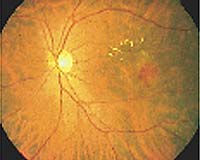
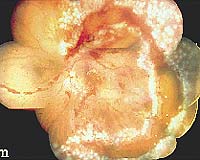 ---Foveal translocation with
partial retinotomy was performed on a patient with subfoveal CNV of 2.9 mm. The
fovea was moved inferonasally by 1.7 mm, and visual acuity changed from 20/70
preop to 20/150 postop.
---Foveal translocation with
partial retinotomy was performed on a patient with subfoveal CNV of 2.9 mm. The
fovea was moved inferonasally by 1.7 mm, and visual acuity changed from 20/70
preop to 20/150 postop.The results of translocation with 360° retinotomy were compared to those of foveal translocation with partial retinotomy and limited translocation with scleral shortening, in both age-related macular degeneration (AMD) and myopic CNV. “At different stages since 1993 we have experienced the three procedures and are now able to compare their anatomical and functional results,” said Dr. Ohji. “We introduced translocation with 360° retinotomy in 1998, and since then foveal translocation surgery has really taken off in our department.”
Foveal translocation in AMD
The first results presented by Dr. Ohji were related to the treatment of subfoveal CNV in AMD. Foveal translocation with partial retinotomy was performed in 6 eyes, limited translocation in 9 eyes and foveal translocation with 360° retinotomy in 34 eyes. The average size of CNV was 2.9 mm (range 1.3 to 4.6), 1.8 mm (range 1.1 to 4.4) and 3.3 mm (range 1.1 to 7.4) respectively. The mean follow up was 32 months (range 12 to 76) in the first group, 26 months (range 6 to 40) in the second group and 9 months (range 3 to 20) in the third group.
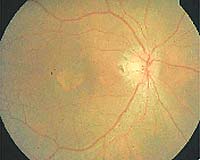
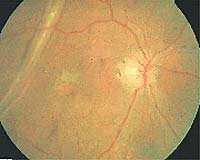 ---In
another case of subfoveal CNV, the sclera was shortened by 7 mm and
the fovea was translocated inferonasally by 1.1 mm. Visual acuity improved
slightly, from 20/150 preop to 20/100 postop.
---In
another case of subfoveal CNV, the sclera was shortened by 7 mm and
the fovea was translocated inferonasally by 1.1 mm. Visual acuity improved
slightly, from 20/150 preop to 20/100 postop.The average foveal movement was 1.0 mm in eyes with partial retinotomy and 1.1 mm in eyes with limited translocation. For 360-degree retinotomy, foveal movement ranged from 1.3 mm to as much as 5.9 mm, with an average of 3.1 mm.
“We found it relatively easy to move the fovea to the intended position by partial retinotomy and 360° retinotomy. It was difficult to control foveal movement with limited translocation,” Dr. Ohji said.
In one case of foveal translocation with partial retinotomy, “The patient had developed subfoveal CNV of 2.9 mm size. Preoperative visual acuity was 20/70. The fovea was moved inferonasally by 1.7 mm, and postoperative visual acuity changed to 20/150,” said Dr. Ohji.
He also showed an example of limited translocation with scleral shortening. “The sclera was shortened by 7 mm in the superotemporal quadrant. Postoperatively, the fovea was translocated inferonasally by 1.1 mm. Visual acuity in this case improved slightly, from 20/150 preop to 20/100 postop.”
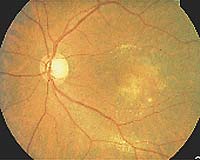
 ---Using foveal
translocation with 360° retinotomy, the fovea was moved superiorly
by 3.4 mm and vision improved from 20/100 to 20/30.
---Using foveal
translocation with 360° retinotomy, the fovea was moved superiorly
by 3.4 mm and vision improved from 20/100 to 20/30.Better results were shown in an example of foveal translocation with 360° retinotomy. The size of CNV was 3.8 mm. “Following excyclorotation of the globe by muscle surgery, the fovea was moved superiorly by 3.4 mm and vision improved from 20/100 to 20/30. The recurrence of CNV was successfully treated by photocoagulation, because there was enough distance between the new fovea and the CNV,” Dr. Ohji explained.
Fluorescein angiography showed an almost normal new macula after surgery.
Comparing visual acuity results

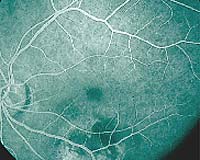 ---The recurrence of CNV was
successfully treated by photocoagulation. Fluorescein angiography showed an
almost normal new macula after the foveal translocation with 360°
retinotomy.
---The recurrence of CNV was
successfully treated by photocoagulation. Fluorescein angiography showed an
almost normal new macula after the foveal translocation with 360°
retinotomy.There was no significant difference in preoperative visual acuity among the three groups of AMD patients. “Postoperatively, a final visual acuity better than 20/40 was achieved in one case of partial retinotomy and in one case of 360° retinotomy. A final visual acuity of 20/80 or better was achieved in 17% of partial retinotomy eyes, in 22% of limited translocation eyes and in 21% of 360° retinotomy eyes. A final visual acuity of 20/20 or better was achieved in 33%, 67% and 50% of cases respectively,” Dr. Ohji said.
Visual acuity improved by 0.2 logMAR units or more in 17% of partial retinotomy eyes, 11% of limited translocation eyes and 18% of 360° retinotomy eyes. Vision improved or remained the same in 17%, 56% and 62% of cases respectively.
Foveal translocation in myopic CNV
In myopic CNV, foveal translocation with partial retinotomy was performed in 1 eye, limited translocation in 8 eyes and 360° retinotomy in 13 eyes. The average size of CNV was 2.4 mm, 1.4 mm (range 0.5 to 2.2) and 2.1 mm (range 1.1 to 3.3) respectively. The mean follow-up was 63 months in the first case, 22 months (range 8 to 41) in the second group and 8 months (range 3 to 13) in the third group.
The average foveal movement was 0.9 mm in partial retinotomy, 1.3 mm in limited translocation and 2.9 mm in 360° retinotomy.

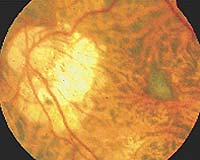 ---In a
case of myopic CNV, limited translocation with scleral shortening was
performed in the left eye. The fovea was translocated inferonasally 1.5 mm.
Visual acuity improved from 20/70 to 20/40.
---In a
case of myopic CNV, limited translocation with scleral shortening was
performed in the left eye. The fovea was translocated inferonasally 1.5 mm.
Visual acuity improved from 20/70 to 20/40.Limited translocation with scleral shortening in the left eye was performed on one of Dr. Ohji’s patients. “The sclera was shortened by 9 mm in the superotemporal quadrant, and postoperatively the fovea was translocated inferonasally by 1.5 mm. Visual acuity in this eye improved from 20/70 to 20/40,” the surgeon said.
Two years later, the patient developed CNV in the right eye. “The size of CNV in the right eye was larger than it had been in the left. We performed translocation with 360° retinotomy. We moved the fovea superiorly by 2.9 mm and vision improved from 20/400 to 20/25.”
Improved visual acuity
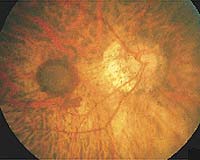
 ---Two years later, the same
patient developed CNV in the right eye. Translocation with 360° retinotomy
was performed and vision improved from 20/400 to 20/25.
---Two years later, the same
patient developed CNV in the right eye. Translocation with 360° retinotomy
was performed and vision improved from 20/400 to 20/25.Preoperative visual acuity in myopic CNV ranged between 20/40 and 20/200 in most patients. A final visual acuity better than 20/40 was achieved in 13% of limited translocation and 39% of 360° retinotomy eyes. A final visual acuity of 20/80 or better was achieved in 50% and 62% of eyes respectively, and a final visual acuity of 20/200 or better was achieved in 63% and 85% of eyes respectively.
“In terms of visual acuity change, visual acuity improved by 0.2 logMAR units or more in 38% of limited translocation eyes, and in 62% of 360° retinotomy eyes. Vision improved or remained the same in 75% and in 92% of cases respectively,” Dr. Ohji said.
Complications
Retinal detachment developed in 71% of partial retinotomy eyes, in 24% of limited translocation eyes and 36% of 360° retinotomy eyes.
Macular pucker developed in 57%, 6% and 11% of eyes respectively, and macular hole developed in 2 cases of 360° retinotomy.
Recurrence of CNV involving the new fovea developed in 24% of limited translocation eyes and in 5% of 360° retinotomy eyes.
After 360° retinotomy, hypotony developed in 2 eyes and bullous keratopathy in 1 eye.
Corneal astigmatism of 3 D or more was seen postoperatively in 71% of limited translocation eyes and in 11% of 360° retinotomy eyes.
“We can’t deny that postoperative complications are still quite frequent in foveal translocation surgery,” Dr. Ohji admitted. “They appear to be more frequent with partial retinotomy, less with 360° retinotomy and least of all with limited translocation. On the other hand, 360° retinotomy compensates for the slightly higher rate of complications with a better predictability and a better visual outcome. I am convinced that it is the most promising procedure of the three, although being a relatively recent technique it needs to be improved to decrease the rate of complications.

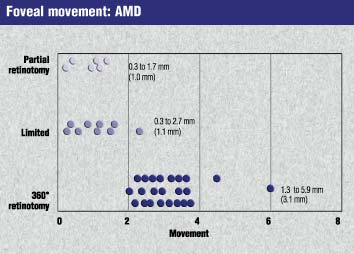
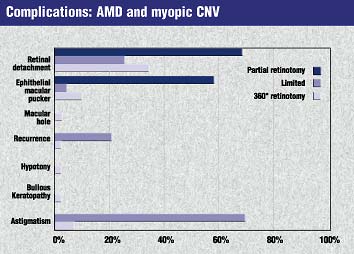
For Your Information:
- Masahito Ohji, MD, can be reached at the Department of Ophthalmology, Osaka University Medical School, 2-2 Yamadaoka, Suita 565-0871, Japan; (81) 668793456; fax: (81) 668793458; e-mail: ohji@ophthal.med.osaka-u.ac.jp. Dr. Ohji has no direct financial interest in the products mentioned in this article, nor is he a paid consultant for any companies mentioned.
